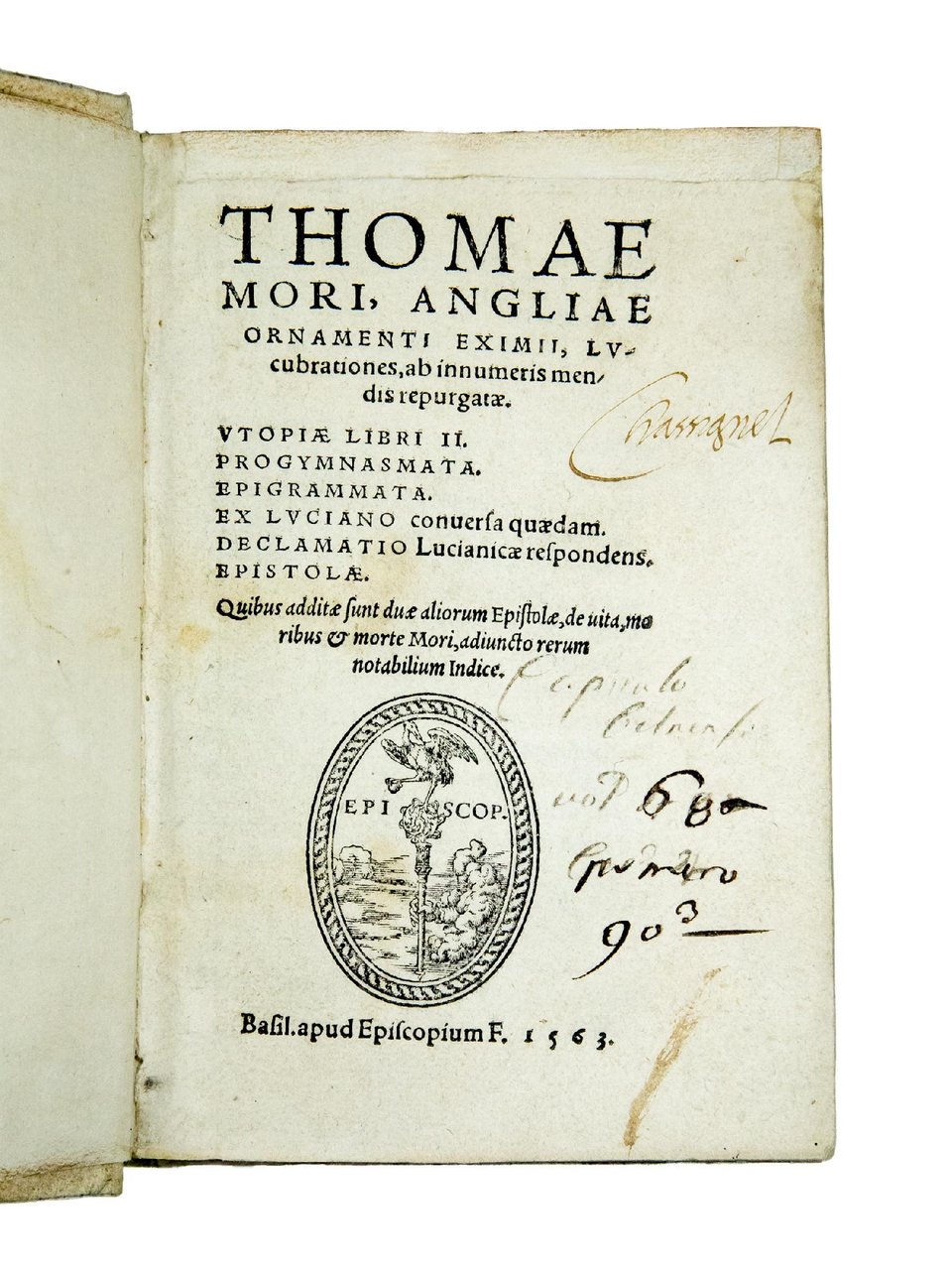

Livres anciens et modernes
MORE, Thomas (1478-1535)
Lucubrationes, ab innumeris mendis repurgatae. Utopiae libri II. Progymnasmata. Epigrammata. Ex Luciano conversa quaedam. Declamatio Lucianicae respondens. Epistolae. Quibus additae sunt duae aliorum Epistolae, de vita, moribus et morte Mori, adiuncto rerum notabilium Indice
Nikolaus Episcopius, 1563
2800,00 €
Govi Libreria Antiquaria
(Modena, Italie)
Les frais d'expédition corrects sont calculés une fois que l'adresse de livraison a été indiquée lors de la création de la commande. Un ou plusieurs modes de livraison sont disponibles à la discrétion du vendeur : standard, express, economy, in store pick-up.
Conditions d'expédition de la Librairie:
Pour les articles dont le prix est supérieur à 300 euros, il est possible de demander un plan de paiement échelonné à Maremagnum. Le paiement peut être effectué avec Carta del Docente, Carta della cultura giovani e del merito, Public Administration.
Les délais de livraison sont estimés en fonction du temps d'expédition de la librairie et de la livraison par le transporteur. En cas de retenue douanière, des retards de livraison peuvent survenir. Les frais de douane éventuels sont à la charge du destinataire.
Pour plus d'informationsMode de Paiement
- PayPal
- Carte bancaire
- Virement bancaire
-
-
Découvrez comment utiliser
votre Carta del Docente -
Découvrez comment utiliser
votre Carta della cultura giovani e del merito
Détails
Description
Adams, M-1752; VD 16, M-6302; R.W. Gibson, St. Thomas More: a Preliminary Bibliography of his Works and Moreana to the Year 1700, (Hamden, CT, 1977), no. 74; Th. More, The Correspondence, E.F. Rogers, ed., (Princeton, NJ, 1947), pp. XV-XXII; B.J. Trapp & H. Schulte-Herbrüggen, ‘The King's Good Servant': Sir Thomas More, Exhibition Catalogue, (London, 1977), p. 133, no. 261.
FIRST COLLECTED EDITION of Thomas More's Latin works, in which are printed for the first time some of his letters.
The volume includes the two books of Utopia with the usual prefatory letters by Erasmus, Guillaume Budé, Pieter Gillis, and by More himself; More's and Lily's Progymnasmata; the Latin epigrams; More's translation of the dialogues of Lucian, along with his Declamatio in response to the latter; 13 letters by More, 1 letter addressed by Erasmus to Ulrich von Hutten on More's life, and 1 letter on More's death generally attributed to Gilbert Cousin, Philippus Montanus, and Eramsus himself.
Among More's letters stands out the famous long letter to Martin Dorp at Louvain dated October 21, 1515 (pp. 365-428), which is, in fact, a vindication of the ‘new learning', and a clear statement of More's intellectual credo. He considered the study of the Greek text of the New Testament much more desirable than the blind acceptance of the Vulgate. This statement was of considerable importance for the development of humanism and of Western thought generally (cf. J.H. Bentley, New Testament Scholarship at Louvain in the Early Sixteenth Century, in: “Studies in Medieval and Renaissance History”, new series, II, 1979, pp. 53-79).
Erasmus' letter to Hutten (pp. 497-510; cf. P.S. Allen, ed., Opus epistolarum Des. Erasmi, Oxford, 1922, IV, no. 999, pp. 12-23), first published in his Farrago nova epistolarum (Basel, 1519), gives a biography of More and a detailed description of his physical appearance. The final letter (pp. 511-530), signed by Covrinus Nucerinus (clearly a pseudonym) and addressed to Philippus Montanus, a pupil of Erasmus, is concerned with More's trial and execution. It had appeared for the first time without place of publication and printer's name, but had actually been printed by Hieronymus Froben in Basel in 1535 (cf. P.S. Allen, ed., Opus epistolarum Des. Erasmi, Oxford, 1947, XI, app. XXVII, pp. 368-378).
“Only ninety-three of More's Latin letters (among them four written under pseudonyms) survive, counting the familiar, the public, and everything in between […] Some of More's letters were suppressed, lost, or destroyed for political reasons, which makes the recent discovery of a manuscript bundle that belonged to Frans van Cranevelt and includes seven hitherto unknown letters by More an extraordinary event. But More himself, in this respect unlike Erasmus, does not seem to have tried to publish his letters (or have them published) as a collection, although clearly he kept copies. In fact, on occasion he withheld publication. In 1520, for instance, he wrote William Budé and asked him not to publish his letters to him, at least until he had revised them, […] In any case, More's situation differed from someone like Erasmus, despite his connections with him. More wrote some of his best-known familiar letters (and most of his official letters) in English, not Latin. Additionally, he was a busy lawyer, judge, administrator, and statesman; humanism was never the whole of his life, and his projections of self and life are multiple, even disparate. To put this another way, More depended much less than Erasmus did upon representing himself as a man of letters, although he was attracted to that sort of life. In fact only twenty-four of More's letters were published – that is, printed – during his lifetime, a

